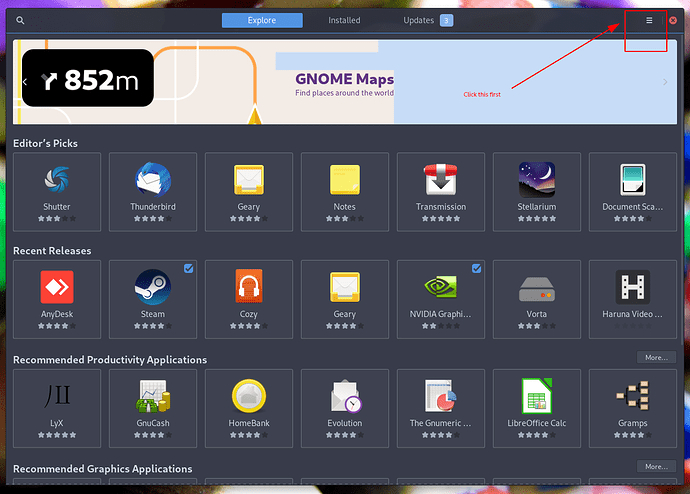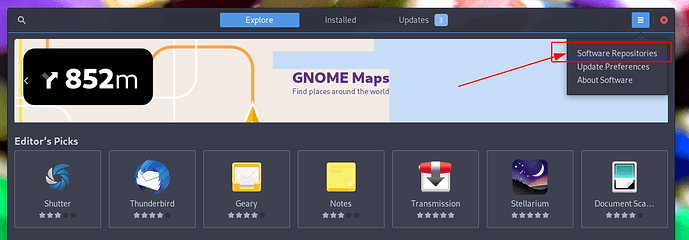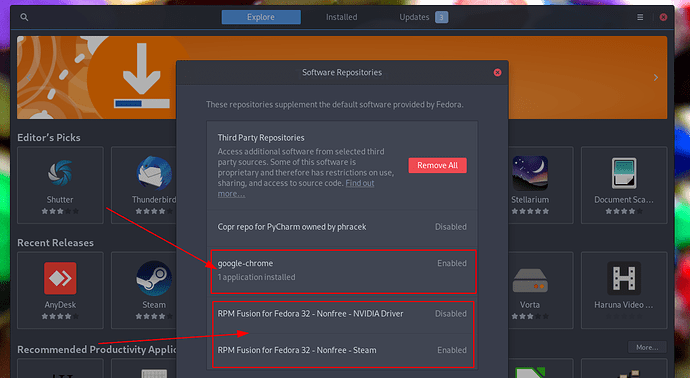Originally published at: Destination Linux 190: Does Linux Need Proprietary Software? - Destination Linux
Krita. Krita is project that should replace GIMP.
It allows better non-destructive editing, masks and some vector graphics support.
Only drawback is that occasionally little regressions happen, but I hope now when KDE moved into Gitlab, automatic test will finally be checked before integrating changes.
Re proprietary vs open source, i think it in the end comes down to money. The reason people use the proprietary programs is because they sell their product and make enough money off of it to make high quality software and enjoyable user experience.
Not saying open source doesn’t produce high quality software, but a lot of the time it ends up being simpler, or a less attractive looking application because the resources aren’t available.
Would one solution could be for open source projects to simply just charge to purchase their app? I mean yeah there will be a bunch of people who will then just get it themselves for free, but the majority of people like myself who barely even know of the existence of things like github, we’d just pay for it because its way simpler than trying to figure out how to build it myself or fork it.
So for example if in the app stores each app had a fixed price, and the choice is either pay for it and click install, or go searching around on the internet and do some magic on the command line to get hold of it for free, most “normal” non techie users would just pay for it.
If you ask me, i’d go for open source anytime. I think that you can have no better support than a lot of people, independent from each other, going over the code you wrote and distributed.
If there are bugs to be killed or improvements to be made, they’ll be added by the community.
Or at least there will be some proposals to do so. That’s something you don’t see often in proprietary software.
On the other hand, this could be it’s downfall also. If nobody is taking the time to take a look at the code you wrote, it will never evolve.
That’s where proprietary software has the upper hand. Those companies pay people to look at the code to make improvements, adjustments, etc.
Here’s a problem though; there are only so much eyes to take a look at the code that has been written.
I think, in the end, the group effort will win. The more people you have, dedicated to a project, the stronger it becomes.
And that’s why i’ll go for open source anytime.
Krita needs to be shouted from the rafters. Having come from a lot Photoshop experience i’ve been back and forth between Krita/GIMP for a long time and there’s just no comparison. Krita should be front and center in any “vs Photoshop” debate, even to the exclusion of all else.
Glimpse is just a fresh coat of paint on a project that isn’t designed to take on Photoshop. Hoisting up a meme of change is a distraction imho when Krita’s the real deal.
Proton Drive vs. Mega ???
At 21:25 You all mention ProtonDrive, The features of e2e encryption for file storage have been in place with Mega for several years now. How does this project differ? I understand that you use GPG for the encryption of the files but Mega also has encrytion as well. The project is also on Github… Thoughts?
Would one solution could be for open source projects to simply just charge to purchase their app? I mean yeah there will be a bunch of people who will then just get it themselves for free, but the majority of people like myself who barely even know of the existence of things like github, we’d just pay for it because its way simpler than trying to figure out how to build it myself or fork it.
So for example if in the app stores each app had a fixed price, and the choice is either pay for it and click install, or go searching around on the internet and do some magic on the command line to get hold of it for free, most “normal” non techie users would just pay for it.
Great point. On this same concept:
Q: Which currently ‘free’ OpenSource app would you now pay for?
… (And, of course, the follow up question is always going to be, “Did you donate in lieu of purchasing it?”)
I have, and do donate to software projects frequently. But, I agree that it is not the same as ‘purchasing’ the software, because:
- I was already using it. (so I personally didn’t gain anything)
- The expectations are very different - When I purchase software (Softmaker Office, for example) there is an expectation that it will perform to whatever value I placed on the cost of the software (license?)… When I am donating to software projects, the expectation is that one day it might get better/easier/more powerful. etc. etc.
One example that comes to mind, I purchased Softmaker Office for its touted compatibility with MS Office. However, after using the office suite for a while, I went back to LibreOffice for its ease of use and open document support. When Softmaker came out with an updated version, I was offered a discount to upgrade my version to the newer one. It boasted a few more features, true, but I’ve been using LibreOffice so much, I instead took the price and donated it to the LibreOffice project. Did my $50 get me any new features? Nope. Did it even cover the cost of an hours worth of code-review or programming? I doubt it.
I don’t think I know of any linux users currently who would object to purchasing commercial-grade software, if it fills a need and is of professional quality.
Packages that could easily charge a $5-$10 donation charge could be the popular products like:
- LibreOffice
- Blender
- Inkscape
- My Paint
… to name a few.
The approach that one distro (Sorry, I can’t remember which one it was) was considering is to put a ‘donate’ button right in the software center. Personally, I rather like this approach, as I do not have to hunt down particular pages on various sites to simply support software I regularly use or rely on.
… Sadly, this may open up a can of worms, as ‘wireguard’, ‘systemD’, ‘ls’, ‘nano’ and a billion backend packages are likely never going to see ‘donate’ buttons. (Like the guy who set out to thank everyone responsible for his cup of coffee ended up thanking over 1,000 people)
Thanks for posting. Great response and points.
Great response thanks, really highlights how difficult it is to monetise open source software. I must admit, I’ve donated to Joplin as I think it’s a great app and I use it for note taking at work,but I haven’t donated to any other projects yet,mostly because I don’t use them extensively.
If its not something you can provide a service contact for, it is very difficult to monetise to any significant degree,and I think in the end for that reason only one or two open source projects really make it as mainstream primary projects.
Glad to see the love for Krita from @Kikuchiyo and @Ulfnic. Whenever Photoshop comes up, I hear GIMP mentioned, but I haven’t heard Krita mentioned. I’m especially surprised that @MichaelTunnell didn’t mention it as a possible project to support to overcome the need for Photoshop since he is a huge advocate of Plasma desktop and QT. I’m a noob with Krita, but I have used it to create my header graphics for my blog.
As I listened to our hosts engage in this debate, one point kept coming up over and over again from @dasgeek and @kernellinux. “Why don’t we have distros pushing open source options first, instead of giving one click options to connect to proprietary garbage?” If that is something you want to encourage, than I believe you already have a large distro trying to do this, but it seems to get mentioned rather infrequently. Fedora has been pushing FOSS first for years. Often the criticisms you hear against Fedora is because they are trying to push FOSS first. Often the reasons why Fedora is not recommended to new users is because they are trying to push FOSS first which makes some things harder for new users out of the box.
On a fresh install of Fedora it is not easy to install Google Chrome out of the box. There is no one click install button for Nvidia drivers. On a fresh install you can’t watch videos with DRM in Firefox. On a fresh install Flatpaks are not enabled by default, so the proprietary software is not shown in the store that is packed as a Flatpak until you enable that repo.
Personally, I love the idea of promoting FOSS first, maybe that is one of the reasons I have gravitated towards Fedora. At the same time, I do enjoy using other distros like MX Linux and Ubuntu Mate as well. Perhaps our hosts could promote Fedora a little more. Maybe if Fedora were spoken about in a more positive light and we made efforts to write articles and make videos that showcased Fedora for new users of Linux we could help promote a distro that attempts to promote FOSS first. If we really want to promote FOSS options first, we might need to think about how we can talk about the struggles this creates so that we cast these struggles in a more a positive light. Instead of saying, “Brand new Linux users might want to stay away from Fedora because it lacks a welcome screen where you can easily install your favorite browser or codecs or drivers for your proprietary graphics card.” We could say instead, “After installing Fedora you have Firefox installed, if you are used to using other web browsers, I would encourage you to give Firefox a try for a week because Firefox tries hard to protect your personal information when you are on the internet. Some video streaming services will not work in Fedora after you install it because those services use DRM, let me explain a little about DRM, and if you still want to watch those videos on your Fedora install here is the documentation to install the necessary software to do so. If you have an AMD or Intel graphics card you will probably have no issues using your graphics hardware under Fedora, however if you have an Nvidia card let me explain why that may not work well after install, and what additional steps you will need to take in order to enable all your hardware. Finally, browse the Software center which Fedora has filled with FOSS that includes games, productivity, and utility programs.”
@mowest So… Krita is a GIMP alternative, then?!? ![]()
![]()
Would it be fair to suggest that Krita and Gimp may overlap in many areas , but each project tends to have a different scope?
Gimp - I always find this more geared towards photo manipulation and editing. (Thus the constant annoying comparison to Photoshop) It seems feature rich in modifying an existing image.
Krita - More a competitor to MyPaint (An awesome program to use with a Wacom tablet if you’ve never tried it) in that it is feature rich in creating from scratch.
I’ve always wanted to rename GIMP to something with a little less potential for offending: Gnu Imaging Not Photoshop. GINP should be much better, right? ![]()
I think it’s a bad time to rename over offense because it’s becoming popular to leverage companies showing weakness to political correctness into promoting people who do offense treasure hunts and offense manufacturing for their own personal elevation.
In this moment in history it’s become a real commodity that buys advertising and buries authentic critical social issues beneath a ton of noise.
That said… GIMP should change it’s name because it’s just a terrible name for a graphics application.
I think you have a point that those two programs have been put into those categories, but all my work with Krita has been the modifying of existing images, and I know that I have only scratched the surface of what it is capable of doing.
minute 40:48 @dasgeek & @kernellinux Both described the initial install and use of Software center on Fedora. There is a one click solution for installing Google Chrome, Nvidia drivers, Flathub & 3rd Party repos, by going to the software center and enable the repo. This has been a feature since Fedora 29/30.
God forbid a company is held to some kind of social standard. Next thing you know there won’t be anything that corporations can use to divide the workers. Can’t have that.
Of course, this is why free software needs to exist. It allows people to fork the code and create the change they want to see. You can’t do that with proprietary software.
Would it be fair to suggest that Krita and Gimp may overlap in many areas , but each project tends to have a different scope?
Well, the thing about is, while Krita indeed is more focused on digital art, it still does image manipulation better than GIMP.
RE: I’ve always wanted to rename GIMP to something a little less potential for offending: Gnu Imaging Not Photoshop. GINP should be much better, right?
No worries. I was speaking tongue-in-cheek. I actually could care less what the software name is. It’s a pretty solid package that does an amazing job. I use it quite substantially for a variety of projects that were more in line with what/how I used to use Photoshop. ![]()
@Kikuchiyo I don’t feel that I have given Krita enough of a fair shake. I need to install and explore this application a good deal more. I enjoy image manipulation and tweaking and if it is simply a matter of adopting a new workflow to get similar (or better) results from Krita vs Gimp, I guess it would only be beneficial to invest the time and effort. Thanks for giving me something to think about. ![]()
You know i’m just a trouble maker @PatPlusLinux ![]()
If anything, GIMP is a good example of why projects shouldn’t be named by their acronym. If we have to explain the abbreviation to a new user it’s a failure in branding. As someone with a disability that has been called a gimp in the past I do find it offensive but I let GIMP slide because I’m aware of the project’s historical context.
+1 on that, intent is really what matters.
I recognize good communication skill is a bit different. Language is sort of meet-me-in-the-middle concept. Words are meaningless without context and context is hard to convey so there has to be some benefit of the doubt for language to work. Both sides have to accommodate each other.
I post on this issue occasionally against even my own advice and likely to my own demise because purposeful misunderstanding is becoming popularized as a social strategy and it’s creeping into Linux as much everywhere else. It’s yet another way people can be cruel but alarmingly under the guise of progress.
I’m all for an inclusive atmosphere and where I see problems is likely an artifact of the quality of company I keep.
My heart’s out to you joseph.
I haven’t tried Glimpse. In my opinion forking a project to change the name is pointless. A project should change if they find it worthwhile to do so, otherwise there isn’t much of a point
A good example is Elementary when they changed a release name from Isis to Freya. At that time the project understood and more importantly recognized concerns some users might have.
My closing point is that it was voluntary.



